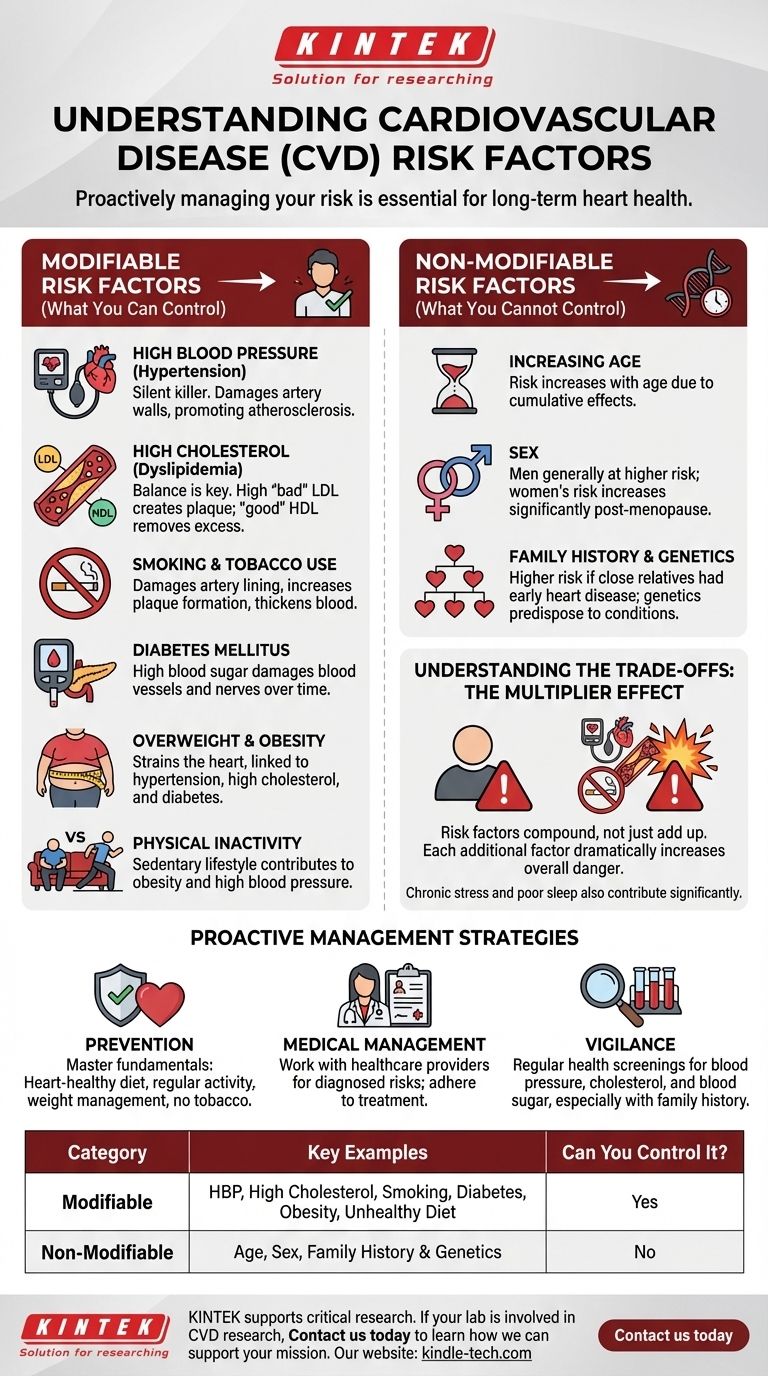Understanding your risk for cardiovascular disease (CVD) begins with recognizing a specific set of health conditions and lifestyle behaviors. The most significant risk factors are high blood pressure, high blood cholesterol, smoking, diabetes, and being overweight or obese. These factors can act alone or in combination to damage your heart and blood vessels over time, significantly increasing the likelihood of events like heart attacks and strokes.
While some risk factors like age and family history are beyond your control, the most impactful drivers of cardiovascular disease are directly linked to lifestyle. Proactively managing these modifiable risks is the single most effective strategy for protecting your long-term heart health.

The Core Modifiable Risk Factors (What You Can Control)
These factors are considered "modifiable" because they can be managed or eliminated through lifestyle changes and, when necessary, medical treatment. They represent the most powerful opportunity to reduce your personal risk.
High Blood Pressure (Hypertension)
High blood pressure is often called the "silent killer" because it typically has no symptoms. It forces your heart to work harder to pump blood, which can stiffen and damage the walls of your arteries over time.
This constant force makes artery walls less elastic and more susceptible to the buildup of plaque, a process known as atherosclerosis.
High Cholesterol (Dyslipidemia)
Cholesterol is a waxy substance necessary for building healthy cells, but too much of it can be dangerous. The key is the balance between two types: low-density lipoprotein (LDL) and high-density lipoprotein (HDL).
High levels of LDL cholesterol, often called "bad" cholesterol, contribute directly to the formation of plaque in your arteries, narrowing the pathways for blood flow. HDL cholesterol is "good" because it helps remove excess cholesterol from the body.
Smoking and Tobacco Use
Smoking is one of the most significant risk factors for CVD. The chemicals in tobacco smoke can damage the lining of your arteries, increase the formation of plaque, and make your blood thicker and more likely to clot.
Even exposure to secondhand smoke carries a measurable risk. Quitting smoking is one of the single most beneficial actions you can take for your heart health.
Diabetes Mellitus
Over time, high blood sugar from diabetes can damage blood vessels and the nerves that control your heart. People with diabetes are also more likely to have other risk factors, including high blood pressure and high cholesterol, which further elevates their CVD risk.
Overweight and Obesity
Excess body weight, especially around the waist, strains the heart and is closely linked to other CVD risk factors. Obesity increases the likelihood of developing high blood pressure, high cholesterol, and diabetes.
Physical Inactivity
A sedentary lifestyle contributes to a host of problems, including obesity and high blood pressure. Regular physical activity strengthens your heart muscle, improves circulation, and helps you maintain a healthy weight.
Unhealthy Diet
A diet high in saturated fats, trans fats, sodium, and added sugar directly contributes to the development of obesity, high blood pressure, and high cholesterol. Conversely, a diet rich in fruits, vegetables, whole grains, and lean proteins is protective.
The Non-Modifiable Risk Factors (What You Cannot Control)
These are factors that are an inherent part of who you are. While you cannot change them, being aware of them is critical for understanding your overall risk profile and the importance of managing what you can control.
Increasing Age
The risk of cardiovascular disease increases for everyone as they get older. The cumulative effect of time and potential exposure to other risk factors leads to gradual changes in the heart and blood vessels.
Sex
Men generally have a higher risk of heart disease than pre-menopausal women. However, after menopause, a woman's risk for CVD increases significantly.
Family History and Genetics
Your risk is higher if a close blood relative (a father or brother diagnosed before age 55, or a mother or sister diagnosed before age 65) had heart disease. Genetic factors can predispose individuals to conditions like high blood pressure or high cholesterol.
Understanding the Trade-offs: The Multiplier Effect
It is crucial to understand that risk factors do not simply add up; they multiply. Each additional risk factor dramatically compounds your overall danger, making a holistic approach to health essential.
How Risk Factors Compound
Having high blood pressure and high cholesterol is far more dangerous than having either one alone. The high pressure damages the artery walls, creating a "foothold" where the excess cholesterol can more easily accumulate into plaque.
This multiplier effect is why a person with diabetes, who smokes, and has high blood pressure is at exceptionally high risk for a cardiovascular event.
The Role of Chronic Stress and Sleep
Factors like chronic stress and poor sleep quality are now recognized as significant contributors. Chronic stress can elevate hormones that increase blood pressure, while lack of sleep is linked to hypertension, obesity, and diabetes.
How to Proactively Manage Your Cardiovascular Risk
Your goal should be to minimize your modifiable risks, especially if you have non-modifiable factors working against you. A discussion with your healthcare provider is the best starting point for a personalized plan.
- If your primary focus is prevention: Prioritize mastering the fundamentals—a heart-healthy diet, consistent physical activity, maintaining a healthy weight, and completely avoiding tobacco.
- If you already have a diagnosed risk factor (like hypertension): Work closely with your healthcare provider for medical management while aggressively addressing the lifestyle factors you can control.
- If you have a strong family history of CVD: Be vigilant with regular health screenings to monitor your blood pressure, cholesterol, and blood sugar to catch potential issues as early as possible.
Proactively understanding and managing these factors empowers you to take direct control of your long-term heart health.
Summary Table:
| Risk Factor Category | Key Examples | Can You Control It? |
|---|---|---|
| Modifiable | High Blood Pressure, High Cholesterol, Smoking, Diabetes, Obesity, Unhealthy Diet | Yes |
| Non-Modifiable | Age, Sex, Family History & Genetics | No |
Take the Next Step in Protecting Your Heart Health
Understanding your risk is the first step. Proactively managing modifiable risk factors is the most powerful strategy for preventing cardiovascular disease. If you are concerned about your heart health or have a family history of CVD, a discussion with your healthcare provider is essential for creating a personalized prevention or management plan.
KINTEK specializes in lab equipment and consumables, serving laboratory needs. Our products support the critical research and diagnostics that help medical professionals understand and combat cardiovascular disease. If your laboratory is involved in cardiovascular research or clinical testing, we can provide the reliable equipment you need.
Contact us today to learn how KINTEK can support your laboratory's mission to advance heart health.
Visual Guide

Related Products
- Inclined Rotary Plasma Enhanced Chemical Vapor Deposition PECVD Equipment Tube Furnace Machine
- Chemical Vapor Deposition CVD Equipment System Chamber Slide PECVD Tube Furnace with Liquid Gasifier PECVD Machine
- RF PECVD System Radio Frequency Plasma-Enhanced Chemical Vapor Deposition RF PECVD
- Customer Made Versatile CVD Tube Furnace Chemical Vapor Deposition Chamber System Equipment
- Split Chamber CVD Tube Furnace with Vacuum Station Chemical Vapor Deposition System Equipment Machine
People Also Ask
- What is PECVD used for? Achieve Low-Temperature, High-Performance Thin Films
- What is the difference between CVD and PECVD? Choose the Right Thin-Film Deposition Method
- How does plasma enhanced CVD work? Achieve Low-Temperature, High-Quality Thin Film Deposition
- What is the difference between PECVD and CVD? Unlock the Right Thin-Film Deposition Method
- What is plasma enhanced chemical vapour deposition process? Unlock Low-Temperature, High-Quality Thin Films



















